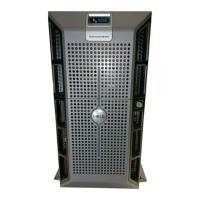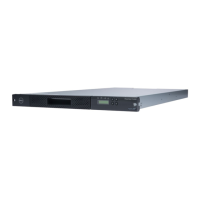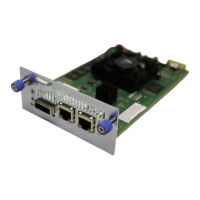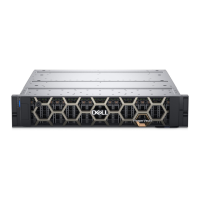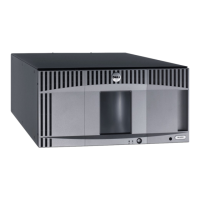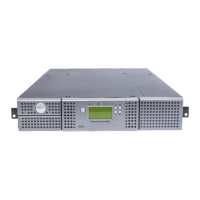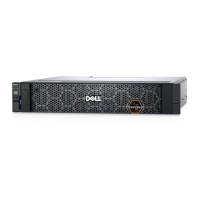
 Loading...
Loading...
Do you have a question about the Dell PowerVault and is the answer not in the manual?
| RAID Levels | 0, 1, 5, 6, 10, 50, 60 |
|---|---|
| RAID Support | Yes |
| Drive Type | SAS, SSD |
| Interface | SAS, Fibre Channel, iSCSI |
| Category | Storage |
| Connectivity | Ethernet, Fibre Channel |
| Scalability | Yes |
| Operating System Compatibility | Windows, Linux, VMware |
| Management Software | PowerVault Manager, OpenManage |
Explains how to access the script engine, specify storage arrays, and set environment parameters.
Provides guidelines for interactive mode, parameter usage, and SMcli command installation path.
Lists CLI commands for identifying storage arrays, setting passwords, adding arrays, specifying communication parameters, and entering script commands.
Lists and defines CLI command parameters such as host-name-or-IP-address, -A, and -a.
Explains how to use quotation marks and backslashes in command arguments on Windows and Linux.
Describes how error data is collected and saved, including parameter/syntax errors and exceptions.
Details exit status values and their meanings, from 0 (no error) to 12 (internal error).
Provides examples of entering CLI commands on Windows and Linux operating systems.
Describes the general structure of script commands: command, operand-data, and statement-data.
Lists general script command categories like activate, autoConfigure, check, clear, create, and deactivate.
Introduces recurring syntax elements and parameters used in script commands, such as raid-level and capacity-spec.
Lists guidelines for writing script commands, including semicolons, spacing, case sensitivity, and user labels.
Details how to add comments to script files using //, /* */, and show statements for documentation.
Explains how to run commands to create virtual disks and configure RAID storage arrays, assuming basic RAID knowledge.
Explains how to use the show storageArray command to determine components and features of an existing or unconfigured storage array.
Describes how to use the save storageArray configuration command to create a script file for saving or copying array configurations.
Explains how to create new virtual disks in three ways: with a new disk group, with MD Storage Manager assignment, or in an existing disk group.
Details creating virtual disks by assigning physical disks, creating a new disk group, and specifying parameters like RAID level and capacity.
Explains creating virtual disks where software assigns physical disks, specifying the number of disks and RAID level.
Describes creating virtual disks within an existing disk group, using commands like show allVirtualDisks.
Explains the enclosureLossProtect parameter and its effect on disk groups when assigning physical disks.
Details the autoConfigure storageArray command for creating disk groups, virtual disks, and hot spares automatically.
Covers modifying configuration properties like storage array password, alerts, RAID controller clocks, host type, and hot spares.
Explains synchronizing RAID controller module clocks with the host for accurate event timestamps.
Details setting the default host type for RAID controller communication with undefined hosts.
Defines modification priority for virtual disk operations and its impact on system performance.
Explains how to assign or unassign physical disks as hot spares using the set physicalDisk command.
Discusses configuring alert notifications for different event levels (Critical, Warning, Debug).
Guides on setting up email alert notifications for errors on the network or specific storage arrays.
Defines snapshot images as logical point-in-time copies and explains their use and differences from legacy snapshots.
Introduces snapshot groups and consistency groups, which support sequences of snapshot images and synchronized operations.
Explains the purpose of snapshot groups, rules for creation, and their repository usage.
Details consistency groups for simultaneous snapshot operations on multiple virtual disks, ensuring data consistency.
Explains repositories as system-created virtual disks used to hold snapshot, snapshot group, and consistency group data.
Describes consistency group repositories used to save data for multiple snapshot virtual disks, enabling host access.
Mentions the need for separate consistency groups for snapshots and remote replication.
Provides guidelines before creating snapshot images, including checks for remote replication and synchronization status.
Explains how to create a snapshot image using the create snapImage command, requiring an existing snapshot group.
Details how to delete the oldest snapshot image from a group using the delete snapshot image command.
Explains creating a snapshot virtual disk from consistency group images, allowing viewable access to specific images.
Describes creating a new snapshot image for each base virtual disk that is a member of a snapshot consistency group using create cgSnapImage.
Explains how to delete snapshot virtual disks or consistency group snapshot virtual disks, with options to delete repository members.
Details deleting snapshot images from a consistency group, noting the state change of associated snapshot virtual disks.
Explains how to schedule regular snapshot images using enableSchedule and schedule parameters for backups or recovery.
Describes starting, stopping, and resuming snapshot rollback operations, and the effect on base virtual disks.
Explains creating a snapshot group, which is a sequence of point-in-time images, and its repository.
Details deleting an entire snapshot group and associated repository virtual disks using the delete snapGroup command.
Explains forcing a snapshot group into an Optimal state if it is in a Failed state.
Describes creating an empty consistency group and adding snapshot groups using set consistencyGroup addCGMember.
Details deleting a snapshot consistency group, with options to retain or delete repository virtual disks.
Explains how to change or set properties for a snapshot consistency group using the set consistencyGroup command.
Guides on adding a new base virtual disk to a consistency group, specifying repository details.
Explains removing a member virtual disk from a snapshot consistency group and optionally deleting repository members.
Describes enabling or disabling pre-read consistency checking for repository virtual disks.
Details increasing or decreasing the capacity of snapshot virtual disk repositories using the set snapVirtualDisk command.
Explains how to increase or decrease the capacity of snapshot group repository virtual disks using the set snapGroup command.
Describes reviving failed components like disk groups, physical disks, snapshot groups, and virtual disks into an Optimal state.
Describes snapshot virtual disks as logical point-in-time images for backup, requiring less space and time than physical copies.
Lists and describes components of a snapshot virtual disk: source virtual disk, snapshot virtual disk, and repository virtual disk.
Lists commands for creating, re-creating, setting properties, and stopping snapshot virtual disks.
Guides on preparing host servers and creating an initial snapshot virtual disk, ensuring proper mapping and state.
Explains the first step of enabling the snapshot virtual disk feature using a feature key file.
Details steps for preparing host servers, including stopping I/O activity and flushing caches, for initial snapshot virtual disk creation.
Provides syntax and examples for creating an initial snapshot virtual disk, defining physical disks or repositories.
Explains creating snapshot virtual disks where software assigns physical disks, defaulting RAID level to the disk group.
Describes creating snapshot virtual disks by specifying the number of physical disks and RAID level for a new disk group.
Lists and describes parameters for the create snapshotVirtualDisk command, such as physicalDiskType and userLabel.
Explains naming conventions for snapshot virtual disks and repository virtual disks, including default naming.
Details changing properties like name, warning threshold, and repository full policy for snapshot virtual disks.
Explains stopping copy-on-write operations and deleting snapshot virtual disks and their associated repository members.
Describes restarting copy-on-write operations for existing snapshot virtual disks using the recreate snapshot virtualDisk command.
Guides on preparing host servers before re-creating snapshot virtual disks, similar to initial creation.
Provides examples of commands to restart snapshot virtual disks.
Explains the Virtual Disk Copy feature for copying data between virtual disks, including its functions like backup and restore.
Describes what happens when starting a virtual disk copy operation, including overwriting data and making the target read-only.
Outlines two types of virtual disk copies: offline (snapshot legacy) and online (point-in-time).
Lists commands related to virtual disk copy operations, such as create, recopy, remove, set, show, and stop.
Guides on creating a virtual disk copy, ensuring a suitable target disk exists and defining source/target disks and copy priority.
Explains enabling the Virtual Disk Copy feature using a feature key file.
Details using show commands to identify candidate virtual disks for source and target roles in copy operations.
Provides steps for preparing host servers, including stopping I/O and flushing caches, before creating a virtual disk copy.
Offers examples of commands to make a virtual disk copy, including parameters for priority and read-only settings.
Explains using the show virtualDiskCopy command to view information about virtual disk copy operations, including status, timestamps, and priority.
Details changing properties like copy priority and target read/write permission for virtual disk copy pairs using the set virtualDiskCopy command.
Explains reinitiating a virtual disk copy operation for existing pairs using the recopy virtualDiskCopy command.
Guides on preparing host servers to recopy a virtual disk, similar to initial copy preparation.
Provides examples for changing copy priority during a recopy operation.
Explains stopping a virtual disk copy operation that is in progress, pending, or failed.
Details removing a virtual disk copy pair from the storage array configuration, which also removes the target read-only attribute.
Mentions that Virtual Disk Copy can run with other features like Storage Partitioning and Snapshot Virtual Disks.
Discusses how legacy snapshots interact with virtual disk copy, including source and target disk types.
Explains storage partitioning for sharing access to virtual disks among hosts and host groups.
Describes Virtual Disk Expansion (VDE) as a dynamic operation to increase virtual disk capacity.
Details how VDE increases capacity using free space and can be performed on primary/secondary virtual disks.
Describes standard asynchronous replication using point-in-time images for resynchronization between local and remote sites.
Details synchronous replication that synchronizes data in real-time, supported only on Fibre Channel.
Explains how Remote Replication enables disaster recovery by providing an exact data duplicate at a remote site for failover.
Describes using Remote Replication for sending data off-site for protection, testing, or backup.
Explains how Remote Replication allows two storage arrays to back up each other for data recovery.
Explains how RAID controller firmware tracks primary virtual disk writes and captures them as point-in-time images for the secondary virtual disk.
Defines replicated pairs and replication repository virtual disks used for managing replication data synchronization.
Compares standard Remote Replication with the legacy version, highlighting performance and configuration differences.
Discusses how link interruptions or errors affect replication status and require resynchronization.
Explains the resynchronization process that occurs after link restorations or virtual disk error corrections.
Describes creating and managing Remote Replication groups on the local storage array, which house replicated pairs with shared settings.
Mentions that legacy replication configurations remain unaffected after firmware upgrades.
Lists requirements like dual-controller configurations and restrictions on distance and connection types for Remote Replication.
Explains the roles of primary and secondary virtual disks and requirements for their creation.
Outlines the steps for setting up Remote Replication: enabling, activating, creating groups, and adding pairs.
Details enabling the Remote Replication premium feature using a feature key file.
Explains activating the premium feature to reserve ports and create repository virtual disks.
Describes creating a new, empty remote replication group on the local storage array.
Explains adding a primary virtual disk to a remote replication group using the add virtualDisk command.
Details changing settings like synchronization intervals and warning thresholds for replication groups.
Explains adding a secondary virtual disk to a replication group using the establish asyncRemoteReplication command.
Describes suspending synchronization to reduce performance impact, with data writes logged to the repository.
Details deleting replication groups from the storage array using the delete asyncRemoteReplicationGroup command.
Explains removing member virtual disks or repository virtual disks from a remote replication group.
Describes disabling the Remote Replication premium feature to prevent new relationships, maintaining existing ones.
Explains deactivating the premium feature after removing all replication relationships.
Mentions running Remote Replication with Snapshot and Virtual Disk Copy features.
Lists available standard Remote Replication commands and their descriptions.
Describes legacy premium feature for online, real-time replication over distance, supporting synchronous or asynchronous transfers.
Explains legacy replication's use for disaster recovery by replicating data to a remote site for failover.
Describes using legacy replication for sending data off-site for protection, testing, or backup.
Explains how legacy replication allows two arrays to back up each other for data recovery.
Explains the process of creating replicated pairs and how the primary virtual disk data is copied to the secondary.
Describes replication repository virtual disks as resources for RAID controller modules, storing replication information.
Details enabling the legacy premium feature and establishing replication relationships by identifying primary and secondary virtual disks.
Explains how RAID controller modules manage data replication and actions taken during link interruptions.
Discusses synchronous and asynchronous write modes and their impact on I/O performance and data consistency.
Describes synchronous write mode for highest data security, though it reduces host I/O performance.
Details asynchronous write mode for faster I/O performance, but without guaranteed completion before the next request.
Explains write consistency mode for multiple replication relationships using asynchronous writes.
Discusses how link interruptions or errors affect replication status and require resynchronization.
Explains the resynchronization process for replicated pairs after interruptions or error corrections.
Outlines steps to create a remote replicated pair, including enabling/activating legacy features and determining candidates.
Provides considerations for performance impact during full synchronization and setting synchronization priority.
Explains enabling the legacy premium feature using a feature key file.
Details activating the legacy premium feature, reserving ports, and creating repository virtual disks.
Explains activating legacy replication by assigning physical disks, creating a new disk group, and specifying RAID level.
Describes activating legacy replication by choosing an existing disk group and letting software assign physical disks.
Details activating legacy replication by specifying the number of physical disks and RAID level for a new disk group.
Explains how to determine candidate virtual disks on a remote array for secondary virtual disks using show commands.
Guides on creating remote replication pairs by defining primary/secondary virtual disks, specifying remote array details, and setting synchronization priority and write mode.
Explains changing property settings for a remote replicated pair using the set remoteReplication command.
Details suspending and resuming replication relationships to control data transfer and reduce performance impact.
Explains removing the link between primary and secondary virtual disks using the remove remoteReplication command.
Describes deleting primary or secondary virtual disks from a storage array, which also removes the replication relationship.
Explains disabling the legacy Remote Replication premium feature to prevent new relationships.
Details deactivating the legacy Remote Replication premium feature after removing all replication relationships.
Mentions running Remote Replication (legacy) with Snapshot and Virtual Disk Copy features.
Explains storage partitioning for sharing access to virtual disks among hosts and host groups.
Describes Virtual Disk Expansion (VDE) as a dynamic operation to increase virtual disk capacity.
Details how VDE increases capacity using free space and can be performed on primary/secondary virtual disks.
Outlines tasks performed periodically to ensure storage array operability and detect potential problems before they occur.
Explains media scan for detecting physical disk media errors, reporting them to the MEL, and identifying potential drive failures.
Details consistency checks performed during media scans, correcting deteriorated data based on RAID levels.
Explains how to reset a RAID controller module, making it unavailable for I/O during the process.
Describes enabling data transfer to revive a quiescent RAID controller module.
Explains resetting the battery age after replacing batteries in the storage array.
Discusses removing persistent reservations to allow changes to LUN mappings or virtual disks.
Explains synchronizing RAID controller module clocks with the host for accurate event timestamps.
Describes turning on indicator LEDs on physical disks to locate them.
Covers monitoring storage array performance and making adjustments using the save storageArray performanceStats command.
Explains monitoring storage array performance and making adjustments using the save storageArray performanceStats command.
Explains how to change the RAID level of virtual disks in a disk group to improve performance or protection.
Describes changing the segment size of virtual disks to optimize performance, especially for multi-user environments.
Explains defragmenting a disk group to consolidate free capacity into a contiguous area.
Introduces SSD cache for improving workload throughput by caching read data.
Details turning SSD caching on or off for virtual disks using the set virtualDisk command.
Explains creating an SSD cache using the create ssdCache command, specifying physical disks and update options.
Describes adding physical disks to an existing SSD cache using the set ssdCache command.
Explains removing physical disks from an SSD cache using the set ssdCache command.
Details using SSD Cache Performance Modeling to estimate potential performance improvements based on cache capacities.
Refers to the Administrator's Guide for more information on SSD Cache and lists related commands.
Covers problem solving techniques for storage arrays, including collecting data and diagnosing controller issues.
Explains collecting sense data from physical disks using the save allPhysicalDisks command to save to a file.
Describes using the diagnose controller command with testID options to verify RAID controller module functionality.
Covers operations like replacing modules, restoring data, and returning the storage array to operation.
Explains setting the RAID controller module's operational mode to Online, Offline, or Service.
Details changing which RAID controller module owns a virtual disk using the set virtualDisk command.
Explains the process of initializing a physical disk, which erases all data and returns it to an unassigned state.
Describes reconstructing data on physical disks after replacing failed disks to return a disk group to an Optimal status.
Explains that virtual disks are initialized automatically on creation and may need re-initialization if failures occur.
Describes returning virtual disks to their preferred RAID controller module owners, including automatic shifting during firmware updates.
Presents general rules for formatting script commands, including case sensitivity and naming conventions.
States the RAID controller module firmware version for commands is 7.70.
Organizes commands into functional groups like Disk Group, Enclosure, Host Topology, Physical Disk, etc.
Lists commands related to disk group management, such as create, delete, set, and show.
Lists commands for managing enclosure firmware, log data, and attributes.
Lists commands for creating, deleting, and setting host and host group properties.
Lists commands for iSCSI initiator and target configuration, sessions, and negotiation defaults.
Lists commands for managing physical disk status, firmware, and security.
Lists commands for setting physical disk hot spare status.
Lists commands for setting physical disk channel status to optimal or degraded.
Lists commands for setting the physical disk state to failed.
Lists commands for diagnosing, enabling data transfer, resetting, and saving RAID controller module information.
Lists commands for activating, adding, canceling, checking, and creating remote replication.
Verifies communication paths between local and remote storage arrays and displays connection details.
Checks a virtual disk for consistency and media errors, writing results to a file.
Resets statistics for all physical disk ports.
Clears sticky faults from remote replication groups and member virtual disks.
Clears storage array configuration to initial state or selectively removes disk group/virtual disk info.
Sets a flag to allow new core dumps to overwrite existing ones on RAID controller modules.
Clears the Major Event Log (MEL) for the storage array.
Deletes downloaded firmware images or NVSRAM values from the pending area buffer.
Forces the storage array to exit recovery mode.
Clears persistent virtual disk reservations.
Clears unreadable sector information from one or more virtual disks.
Enables or disables automatic collection of support bundles when a critical MEL event is detected.
Migrates legacy snapshot virtual disks to snapshot groups and converts legacy repositories.
Creates a new, empty consistency group that can contain snapshot groups.
Creates a new snapshot image for each base virtual disk that is a member of a snapshot consistency group.
Creates a snapshot virtual disk of specific images within base virtual disks of a consistency group.
Creates a logical mapping from a consistency group snapshot virtual disk to a host or host group.
Creates a read-only snapshot virtual disk for snapshot images of a base virtual disk.
Describes creating a new, empty remote replication group on local and remote arrays to manage replicated pairs.
Creates a snapshot virtual disk, allowing definition via user-defined physical disks, disk groups, or disk count.
Explains creating a snapshot group, which is a sequence of point-in-time images, and its repository.
Creates a new snapshot image in one or more existing snapshot groups.
Creates a read cache using SSDs to improve application I/O performance and response times.
Deactivates the Remote Replication feature, disassembling repositories and releasing ports.
Deletes a snapshot consistency group and optionally its repository virtual disks.
Deletes snapshot images from a consistency group, with options for count, retention, and ignoring virtual disk association.
Deletes the snapshot virtual disk of a consistency group and optionally its repository members.
Deletes an entire disk group and its associated virtual disks.
Deletes a disk pool, including any virtual disks within it.
Deletes a host, including all host definitions in its group.
Deletes a host group and all host definitions within it.
Deletes HBA host port identification, preventing further communication with that port.
Deletes a specific iSCSI initiator object.
Deletes an entire snapshot group and optionally associated member virtual disks.
Deletes one or more snapshot images from a snapshot group.
Deletes one or more legacy snapshot virtual disks or repository virtual disks, or removes schedules.
Deletes a snapshot virtual disk and optionally its associated snapshot repository members.
Deletes snapshot virtual disks or their schedules, with a caution to avoid inadvertent deletion.
Deletes the SSD cache, purging all data.
Deletes virtual disks or snapshot repository virtual disks, including any associated data.
Deletes normal or thin virtual disks from a disk pool, with options to remove disk groups and retain repositories.
Runs diagnostic tests on the RAID controller module.
Runs diagnostic tests on copper cables between iSCSI host interface cards and RAID controller modules.
Tests communication paths between local and remote storage arrays for replication groups.
Disables a storage array feature, such as Remote Replication or Snapshot.
Displays the automatic support bundle collection settings.
Displays the schedule for collecting support bundles for all storage arrays.
Downloads firmware for the enclosure management module.
Downloads a firmware image to a physical disk, with precautions for data loss.
Downloads firmware and optionally NVSRAM values for RAID controller modules.
Downloads firmware images to all physical disks in the storage array.
Downloads NVSRAM values for the storage array RAID controller module.
Converts a non-secure disk group to a secure disk group.
Converts a non-secure disk pool to a secure disk pool.
Turns SSD caching on or off for specific virtual disks.
Describes enabling data transfer to revive a quiescent RAID controller module.
Enables a premium feature using a feature key file.
Completes a remote replicated pair by adding a secondary virtual disk to an existing remote replication group.
Defines properties for a virtual disk and increases its capacity, potentially using physical disks.
Uploads a DBM database image from a file or cache to restore the storage array configuration.
Adds capacity to a disk pool or changes RAID controller module ownership.
Reinitiates a virtual disk copy operation using an existing virtual disk copy pair.
Creates a new Remote Replication repository virtual disk using parameters from a previous one.
Starts a new copy-on-write operation using an existing snapshot virtual disk or multiple virtual disks.
Re-initializes a thin virtual disk, which is a long-running operation that cannot be stopped.
Removes orphaned replicated pair virtual disks from a remote replication group due to communication issues.
Removes a member virtual disk from a snapshot consistency group and optionally deletes repository members.
Decreases SSD cache capacity by removing Solid State Disks.
Removes the replication relationship between primary and secondary virtual disks in a remote replication pair.
Removes a virtual disk copy pair.
Explains removing member virtual disks or repository virtual disks from a remote replication group.
Removes the logical unit number (LUN) mapping between a virtual disk and a host or host group.
Renames an existing snapshot virtual disk.
Changes the name of the SSD cache.
Repairs consistency errors on a virtual disk.
Redefines disk group composition by replacing a physical disk with an unassigned disk or a hot spare.
Resets the iSCSI IP address for a remote storage array to re-establish connection.
Resets a RAID controller module, potentially causing unavailability for I/O operations.
Resets synchronization statistics for member virtual disks in a remote replication group to zero.
Resets the battery age for storage arrays or specific RAID controller modules to zero days.
Resets the iSCSI baseline for the storage array to 0.
Resets the SAS physical layer (SAS PHY) baseline for devices.
Reassigns virtual disks to their preferred RAID controller modules.
Restarts a copy-on-write operation for a consistency group snapshot virtual disk that was stopped.
Resumes a suspended Remote Replication operation.
Resumes data transfer for all replicated pairs in a remote replication group.
Resumes a rollback operation for snapshot images that entered a paused state.
Resumes a rollback operation for snapshot (legacy) virtual disks that entered a paused state.
Resumes a snapshot virtual disk operation that was stopped.
Restarts caching for virtual disks using the SSD cache after it was stopped.
Forces a specified disk group and associated failed physical disks to the Optimal state.
Forces a disk pool and its associated physical disks to the Optimal state.
Forces a specified physical disk to the Optimal state.
Forces a specified snapshot group to the Optimal state.
Forces a specified snapshot virtual disk to the Optimal state.
Saves enclosure log sense data to a file.
Saves physical disk channel fault isolation diagnostic data to a file as text or XML.
Saves log sense data to a file for each physical disk.
Saves a copy of RAID controller module NVSRAM values to a file.
Saves synchronization statistics for member virtual disks in a remote replication group to a file.
Creates a script file to create the current storage array virtual disk configuration.
Saves the core dump to a specified file on a host.
Saves the database management (DBM) of the storage array, retrieving multiple backup locations.
Generates an XML file containing DBM validation information for generating a validator string.
Saves events from the Major Event Log (MEL) to a file, including critical, warning, informational, and debug events.
Saves iSCSI performance statistics of the storage array to a file.
Saves performance statistics to a file, after setting performance monitor intervals.
Saves storage array SAS physical layer (SAS PHY) counters to a file.
Saves the state capture to a file.
Saves storage array support-related information to a file, including profile, logs, and firmware versions.
Specifies a schedule for collecting support bundle data when a critical MEL event is detected.
Explains scheduling automatic snapshots daily, weekly, or monthly using enableSchedule and schedule parameters.
Explains how to change or set properties for a snapshot consistency group, including repository policy and rollback priority.
Creates a unique name for a snapshot virtual disk of a consistency group.
Defines properties for a disk group, including physical disks, RAID level, and owner.
Discusses troubleshooting Dynamic Capacity Expansion (DCE) failures and insufficient cache memory.
Moves a disk group into a Forced state for importing or identifying hardware errors.
Sets attributes for a disk pool, including reserve capacity, warning thresholds, and security type.
Sets a disk pool from an Incomplete state to the Complete state.
Sets user-defined attributes for an enclosure, such as chassis name or asset tag.
Sets the ID of an enclosure in a storage array.
Adds missing foreign physical disks back into their original disk group for recovery.
Assigns a host to a host group or moves it to a different group.
Defines the loop ID for the host channel.
Renames a host group.
Changes the host type for an HBA host port or its label.
Sets the attributes for an iSCSI initiator.
Defines properties for an iSCSI target, including authentication method and target alias.
Defines how the physical disk channel performs, setting status to optimal or degraded.
Assigns or unassigns physical disks as hot spares.
Sets a physical disk to the Failed state.
Defines attributes for RAID controller modules, including availability and port options.
Changes a read-only snapshot virtual disk to a read/write virtual disk, optionally defining the repository.
Defines properties for a remote replication pair, including role, priority, and write mode.
Changes synchronization settings and warning thresholds for remote replication groups.
Defines how the current script engine session runs, including error handling and performance monitoring.
Explains how to change or set properties for a snapshot group, including repository policy and rollback priority.
Runs a media scan on a snapshot group and performs consistency checks.
Details increasing or decreasing the capacity of snapshot group repository virtual disks using the set snapGroup command.
Defines the schedule for taking snapshot images for a snapshot group.
Defines properties for a snapshot virtual disk and allows renaming it.
Explains scheduling automatic snapshots (legacy) daily, weekly, or monthly using enableSchedule and schedule parameters.
Runs a media scan on physical disks for a snapshot virtual disk and performs consistency checks.
Defines the capacity for a snapshot virtual disk repository virtual disk.
Defines the properties of the storage array.
Defines cache block sizes for storage arrays based on I/O stream characteristics.
Defines values to start and stop cache flushes, affecting cache performance.
Affects virtual disks mapped in the default group when Storage Partitioning is enabled.
Configures the frequency at which media scans run on a storage array.
Details password requirements for storage arrays, including length and character types.
Defines the position of enclosures in a storage array, including RAID and expansion enclosures.
Returns default values for negotiable settings for sessions and connections.
Sets the configuration method and address for an IPv4 Internet Storage Name Service (iSNS) server.
Sets the IPv6 address for the iSNS server.
Sets the iSNS server listening port.
Sets the learn cycle for the battery backup unit to predict remaining battery life.
Sets the redundancy mode of the storage array to simplex or duplex.
Sets the security key used for Physical Disk Security premium feature.
Sets the clocks on RAID controller modules by synchronizing with the host clock.
Enables the storage array to participate in unnamed discovery sessions.
Defines properties for a thin virtual disk, allowing configuration for one or more disks.
Defines properties for a virtual disk, with syntax for multiple disks, single disks, and mapping.
Defines properties for a virtual disk, applicable to one or more disks, and lists syntax for mapping.
Explains the cacheReadPrefetch parameter for copying additional data blocks into cache to improve future requests.
Defines segment size and its impact on performance, especially for large data transfers.
Defines properties for a virtual disk copy pair, including copy priority and target read-only settings.
Defines LUN mapping between a virtual disk and a host or host group.
Shows one or more snapshot images within snapshot consistency groups.
Displays information about iSCSI sessions for initiators or targets.
Returns information about a disk group, including status, physical disk type, and owner.
Shows dependencies for physical disks in a disk group intended for moving between storage arrays.
Shows dependencies for physical disks in a disk group that is being moved.
Returns information on used and free capacity and other properties for a disk pool.
Returns information about HBA host ports connected to the storage array.
Returns information about each physical disk in the storage array.
Shows cumulative physical disk channel data transfer and error information.
Returns the status of firmware downloads for physical disks.
Returns information about RAID controller modules, including status, firmware, and associated virtual disks.
Returns a list of NVSRAM byte values for a specified host type.
Displays configuration information for remote replication groups and their associated replicated pairs.
Displays the progress of periodic synchronization for remote replication groups.
Returns candidate virtual disks on a remote array for secondary virtual disks.
Shows synchronization progress for primary and secondary virtual disks in Remote Replication.
Returns information about one or more snapshot image groups.
Returns information about snapshot images created by a user.
Returns information about one or more snapshot virtual disks.
Displays information about the SSD cache, including status, capacity, and associated disks.
Shows the amount of SSD cache storage allocated, expressed as a percentage.
Shows the amount of SSD cache storage containing data, expressed as a percentage.
Returns configuration information about the storage array, including components and features.
Displays all logical and physical component properties of the storage array.
Shows the default autoconfiguration settings created by the storage array.
Shows details of the core dump on the RAID controller module cache.
Saves the database management (DBM) of the storage array, retrieving multiple backup locations.
Returns storage partition topology, host type labels, and host type index.
Returns information about storage array LUN mappings.
Returns information about connection-level settings subject to negotiation.
Returns a list of detected iSCSI initiators not yet configured in the array topology.
Returns a table of addresses of sectors in the storage array that cannot be read.
Shows a string of text from a script file, similar to echo commands.
Returns expansion history or consumed capacity for specified thin virtual disks.
Returns information about virtual disks, including number, name, status, capacity, RAID level, and disk group.
Returns information about virtual disk actions and the progress of long-running operations.
Returns information about virtual disk copy operations, including status, timestamps, and priority.
Returns information about candidate virtual disks that can be used as sources for virtual disk copy operations.
Returns information about candidate virtual disks that can be used as targets for virtual disk copy operations.
Returns performance information about virtual disks in a storage array.
Returns information about virtual disks that have persistent reservations.
Starts a diagnostic test to validate the configuration database in the controller firmware.
Starts a rollback operation to member base virtual disks in a snapshot consistency group.
Identifies physical disks in a disk group by blinking indicator LEDs.
Starts a defragment operation on a specified disk group.
Moves a disk group into an Exported state for removal and reinstallation in another array.
Moves a disk group into a Complete state to make it available to a new storage array.
Initiates a location operation on physical disks in a specified disk pool.
Identifies an enclosure by turning on its indicator LED.
Initiates a refresh of network address information for the iSNS server.
Blinds a physical disk by turning on its indicator light.
Identifies expansion enclosures connected to a specific physical disk port by blinking indicator lights.
Runs physical disk channel fault isolation diagnostics and stores the results.
Starts physical disk initialization, which erases all user data.
Starts reconstructing a physical disk.
Starts Remote Replication synchronization for a group.
Starts legacy Remote Replication synchronization.
Erases data from SED physical disks so they can be reused as SED disks.
Starts a rollback operation for snapshot virtual disks.
Starts a rollback operation for a set of snapshot images.
Starts performance modeling for SSD cache to estimate performance based on cache size.
Identifies a storage array by turning on its indicator LED.
Runs a consistency check against a configuration database.
Initiates a refresh of network address information for the iSNS server.
Starts the formatting of a virtual disk in a storage array.
Stops a diagnostic test for the configuration database.
Stops a rollback operation for member base virtual disks in a snapshot consistency group.
Stops the copy-on-write operation for creating a consistency group snapshot virtual disk.
Turns off the indicator LED on a physical disk that was turned on by the start diskGroup blink command.
Turns off indicator lights on physical disks that were turned on by the start diskPool locate command.
Turns off the indicator LED on an enclosure that was turned on by the start enclosure blink command.
Stops pending snapshot images to be created on a snapshot consistency group.
Turns off the indicator light on a physical disk.
Turns off indicator lights on expansion enclosures connected to a physical disk port.
Stops physical disk channel fault isolation diagnostics before completion.
Cancels a pending snapshot image copy-on-write operation on a snapshot image group.
Cancels all pending snapshot images to be created on a snapshot group or consistency group.
Stops a copy-on-write operation for legacy snapshot virtual disks.
Stops a snapshot rollback operation initiated by the start rollback virtual disk command.
Stops a snapshot rollback operation initiated by the start rollback virtual disk command.
Stops a snapshot image rollback operation initiated by the start snapImage rollback command.
Stops a snapshot virtual disk operation.
Stops performance modeling for SSD cache and displays the data.
Turns off indicator lights on the storage array.
Stops a diagnostic test for the configuration database.
Forces the termination of an iSCSI session.
Stops a firmware download to physical disks that are waiting.
Stops a virtual disk copy operation.
Suspends a Remote Replication operation.
Suspends data synchronization for all replicated pairs in a remote replication group.
Stops caching for virtual disks using the SSD cache.
Tests communication problems between local and remote storage arrays for replication groups.
Validates the security key for storage arrays with self-encrypting disk physical disks.
Explains creating script files using save storageArray configuration or by writing a script manually.
Demonstrates creating a new virtual disk using create virtualDisk and setting additional attributes.
Shows creating a new virtual disk using create virtualDisk with user-defined physical disks.
Lists newly added commands reflecting additional functionality in MD32xx and MD36xx series.
Lists commands with syntax modifications or enhancements since the last document release.

